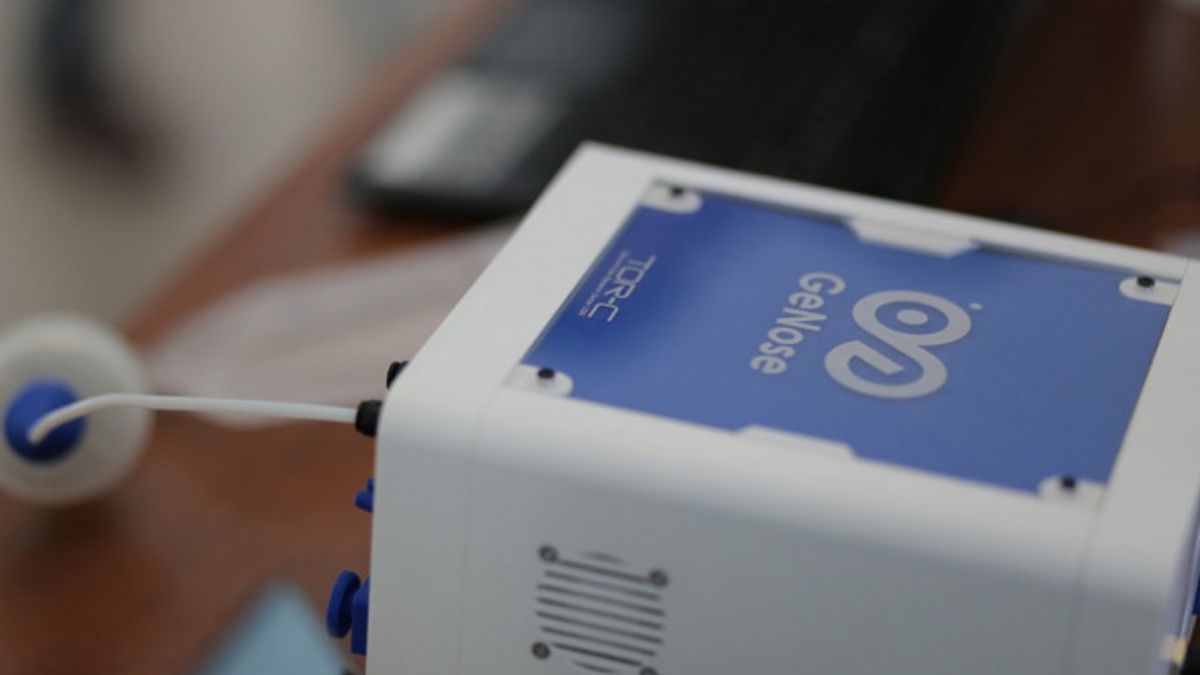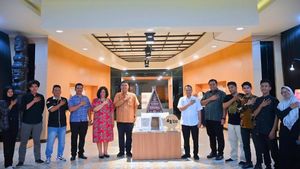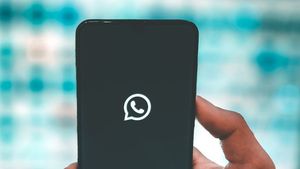JAKARTA - The COVID-19 GeNose C19 screening tool is increasingly being used in public places. After being widely used in several train stations, starting tomorrow this tool can be used at airports. However, the widespread use of GeNose is directly proportional to the increasing number of criticisms. Many parties have asked about the accuracy of the tool made by the Gadjah Mada University (UGM) scientist.
GeNose was initiated by Eng Kuwat Triyana and Ahmad Kusumaatmaja from the Faculty of Mathematics and Natural Sciences UGM, and Dian Kesumapramudya Nurputra and Mohamad Saifudin Hakim from the Faculty of Medicine, Public Health and Nursing. This tool has obtained a distribution permit since December 24 last year.
After obtaining a distribution license, GeNose C19 was then mass produced. Kuwat, as the head of the GeNose development team, initially targeted 10 thousand units until last month. With that much equipment, the number of COVID-19 tests per day could reach 1.2 million people per day.
"Of course, it is not only figures like that we all hope, but the ability to test that much is expected to find people infected with Covid-19 without symptoms (OTG) and immediately take isolation or treatment measures so that the chain of the spread of Covid-19 can be cut immediately. , "Said Kuwat quoted on the UGM website.
GeNose is also claimed to have the ability to detect the new corona virus in the human body quickly. No less than 2 minutes of the test results can be seen whether positive or negative COVID-19. "Previously it took about 3 minutes, yesterday when we tested it at BIN, it could drop to 80 seconds so that it is even faster," said Kuwat.

According to a member of the GeNose Development Team, Dian Kesmapramudya Nurputra, the way GeNose identifies the corona virus is by detecting Volatile Organic Compound (VOC). Dian said, the VOC was formed because of the COVID-19 infection that came out with the breath. For this reason, those who were examined with GeNose were first asked to exhale into a special bag.
Then, the sensors in the bag work to detect VOCs. Then, the data obtained is processed using artificial intelligence to produce results. And in less than 2 minutes, GeNose can detect whether someone is positive or negative Covid-19.
Before GeNose, the recognized COVID-19 identification tools were the PCR and Antigen swab test. The three of them have different methods.
How PCR worksIf GeNose uses a breath sample to detect the new coronavirus, the PCR test uses a mucus sample taken from the nose or throat. The goal is to find genetic material from the corona virus.
Next, the sample is put into a special tube to be examined in the laboratory. In the next stage, the sample is extracted using a certain kit in order to remove the virus material that is being sought.
After the genetic material of the virus is obtained, it is then amplified using a real time PCR machine. This process can be done up to about 40 cycles.
The PCR machine uses fluorescent technology so that every time it is reproduced, a fluorescent signal is formed. The number of signals is directly proportional to the amplification that occurs.
In the circular of the Association of Indonesian Clinical Microbiology Specialists (PAMKI) quoted by Klikdokter, it was stated that the results of the real-time PCR examination were positive if there was an accumulation of fluorescent signals. And the signal is influenced by the CT (cycle threshold) value. What is that?
The CT value is the number of cycles required for the fluorescent signal to exceed or cross the threshold. In other words, the lower the CT value, the higher the target nucleic acid count, and this indicates a new coronavirus infection.
In general, the threshold for CT is 40. If the CT value is 29-37, this is considered positive. Whereas CT 38-40 was weakly positive. However, some reagent kits carry different thresholds. For example 41, 35, or 38. For this reason, the interpretation of PCR results must be readjusted.
How antigens workWhereas for the antigen test, the sampling is similar to PCR, which uses a mucus sample taken from the nose or throat using the swab method. From the samples taken, this tool identifies the virus in nasal and throat secretions.
The antigen test results come out faster than PCR, which only takes 10-15 minutes. However, the antigen swab is only able to detect the virus when the viral load is high.
However, when the virus count is not too high, the CT (cycle threshold) value is above 25 or above 30, the antigen will be negative. In fact, this patient contains the new corona virus, so the antigen is less sensitive than PCR.

Of the three methods of testing for COVID-19, the one that is considered the most accurate is PCR. Because the level of accuracy is said to be close to 100 percent.
Meanwhile, the accuracy of the antigen is considered to be under PCR. It is known, the antigen rapid test has a maximum sensitivity of 94 percent and a specificity of more than 97 percent.
Then what about the accuracy of GeNose? This tool is actually claimed to have a fairly high level of accuracy, namely 93-95 percent. If the patient is tested positive in one breath bag, he is advised to do a PCR examination on day 2 or 3 after taking the GeNose sample.
Then if it is claimed to have high enough accuracy, the question is, why is GeNose receiving a lot of criticism?
Reap criticismMany have criticized the use of GeNose as a COVID-19 screening tool. Virologist from the Veterans National Development University Jakarta Andri Pramesyanti is one of them. When contacted by VOI, he highlighted the GeNose method, which still needed to be tested for its feasibility.
Andri explained that the GeNose COVID-19 detection method basically looks at the profile of a volatile compound or VOC. It is created by the metabolic processes of cells and tissues in the body. "If there is a disease, the (VOC) profile will be different ... Like cancer or infection," said Andri, March 31.
Meanwhile, what is the question of this GeNose tool, according to Andri, is whether the tool can really distinguish the specificity of the new corona virus or not. What if there are other similarities such as pneumonia, for example?
"Is it true only for people with COVID-19? Can you tell the difference between those with other pneumonia virus infections?" Andri explained.
For that, said Andri, the specificity and sensitivity of GeNose needs to be further tested with more samples. "So that the statistical counts meet research standards."
Apart from Andri, criticism also came from the Epidemiologist Griffith University Australia, Dicky Budiman. He said GeNose had not yet become a recommendation from WHO to screen travelers.
"The selection of screening must consider WHO recommendations. What is clear is that so far WHO has only recommended two, namely PCR and rapid antigen test. GeNose is not only used because it is cheap, easy, and domestically produced. Not that," said Dicky to VOI.
According to Dicky, if you want to control the transmission of COVID-19 in the movement of the community, it means you have to choose quality and recommended ones.
"When it comes to genose context, it is true that there is potential for screening. But in the current context, I recommend doing it in a health facility setting first, while testing the general population with a large sample, so that it can validate the results later," said Dicky.
BERNAS OthersThe English, Chinese, Japanese, Arabic, and French versions are automatically generated by the AI. So there may still be inaccuracies in translating, please always see Indonesian as our main language. (system supported by DigitalSiber.id)









